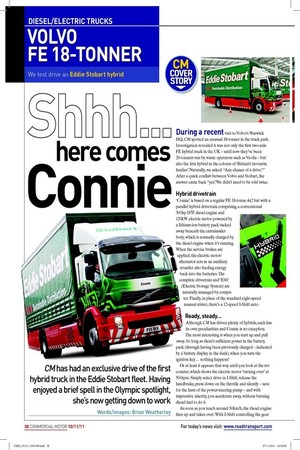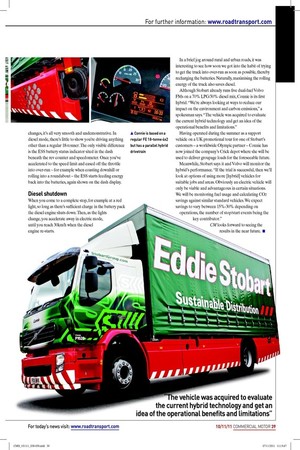here comes
Page 30

Page 31

If you've noticed an error in this article please click here to report it so we can fix it.
onnie
CM has had an exclusive drive of the first hybrid truck in the Eddie Stobart fleet. Having enjoyed a brief spell in the Olympic spotlight, she’s now getting down to work
Words/images: Brian Weatherley
During a recent visit to Volvo’s Warwick HQ, CM spotted an unusual 18-tonner in the truck park. Investigation revealed it was not only the irst two-axle FE hybrid truck in the UK – until now they’ve been 26-tonners run by waste operators such as Veolia – but also the irst hybrid in the colours of ‘Britain’s favourite haulier’. Naturally, we asked: “Any chance of a drive?” After a quick conlab between Volvo and Stobart, the answer came back “yes”. We didn’t need to be told twice.
Hybrid drivetrain
‘Connie’ is based on a regular FE 18-tonne 4x2 but with a parallel hybrid drivetrain comprising a conventional 300hp D7F diesel engine and 120kW electric motor powered by a lithium-ion battery pack tucked away beneath the curtainsider body, which is normally charged by the diesel engine when it’s running. When the service brakes are applied, the electric motor/ alternator acts as an auxiliary retarder also feeding energy back into the batteries. The complete drivetrain and ‘ESS’ (Electric Storage System) are naturally managed by computer. Finally, in place of the standard eight-speed manual stirrer, there’s a 12-speed I-Shift auto.
Ready, steady...
Although CM has driven plenty of hybrids, each has its own peculiarities and Connie is no exception. The most interesting is when you start up and pull away. So long as there’s suficient power in the battery pack (through having been previously charged – indicated by a battery display in the dash), when you turn the ignition key... nothing happens!
Or at least it appears that way until you look at the rev counter, which shows the electric motor ‘turning over’ at 500rpm. Simply select drive in I-Shift, release the handbrake, press down on the throttle and silently – save for the hum of the power-steering pump – and with impressive alacrity, you accelerate away, without burning diesel fuel to do it.
As soon as you reach around 30km/h, the diesel engine ires up and takes over. With I-Shift controlling the gear changes, it’s all very smooth and undemonstrative. In diesel mode, there’s little to show you’re driving anything other than a regular 18-tonner. The only visible difference is the ESS battery status indicator sited in the dash beneath the rev counter and speedometer. Once you’ve accelerated to the speed limit and eased off the throttle into over-run – for example when coasting downhill or rolling into a roundabout – the ESS starts feeding energy back into the batteries, again shown on the dash display.
Diesel shutdown
When you come to a complete stop, for example at a red light, so long as there’s suficient charge in the battery pack the diesel engine shuts down. Then, as the lights change, you accelerate away in electric mode, until you reach 30km/h when the diesel engine re-starts. In a brief jog around rural and urban roads, it was interesting to see how soon we got into the habit of trying to get the truck into over-run as soon as possible, thereby recharging the batteries. Naturally, maximising the rolling energy of the truck also saves diesel.
Although Stobart already runs ive dual-fuel Volvo FMs on a 70% LPG/30% diesel mix, Connie is its irst hybrid. “We’re always looking at ways to reduce our impact on the environment and carbon emissions,” a spokesman says. “The vehicle was acquired to evaluate the current hybrid technology and get an idea of the operational beneits and limitations.” Having operated during the summer as a support vehicle on a UK promotional tour for one of Stobart’s customers – a worldwide Olympic partner – Connie has now joined the company’s Crick depot where she will be used to deliver groupage loads for the foreseeable future.
Meanwhile, Stobart says it and Volvo will monitor the hybrid’s performance. “If the trial is successful, then we’ll look at options of using more [hybrid] vehicles for suitable jobs and areas. Obviously an electric vehicle will only be viable and advantageous in certain situations. We will be monitoring fuel usage and calculating CO2 savings against similar standard vehicles. We expect savings to vary between 15%-30% depending on
operations, the number of stop/start events being the key contributor.”
CM looks forward to seeing the results in the near future. ■











































